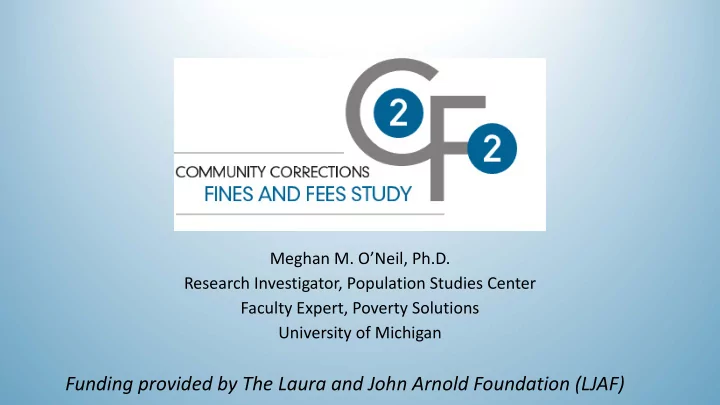

Meghan M. O’Neil, Ph.D. Research Investigator, Population Studies Center Faculty Expert, Poverty Solutions University of Michigan Funding provided by The Laura and John Arnold Foundation (LJAF)
Definitions • Fines • Financial obligations imposed as a penalty after a criminal conviction or admission of guilt to a civil infraction • Fees • Financial obligation imposed to recoup costs for use of the criminal justice system
Overall Study Overview Indiana Michigan Texas Pennsylvania North Carolina Massachusetts Arizona
Statement of the Problem • 4.6 million people in the United States are on community supervision any given day • One of the primary reasons offenders are re-incarcerated after serving their sentence stems from FINES & FEES that result in parole or probation revocation • 2015 – DOJ Ferguson Report: • “…Ferguson’s municipal court routinely issues warrants for people to be arrested and incarcerated for failing to timely pay related fines and fees.” 1 • The imposition of fine and fees were primarily used against minorities and the poor 1 United States Department of Justice Civil Rights Division, 2015
Controversy • Poverty penalties and poverty traps • Ability to pay determination • Transparency and accountability- who pays $$ and why? • Conflict of interest if salaries rest upon fines
Widespread Concern • National and local news outlets • Vox, HBO, Vice, NPR, WWLP-22 (MA), WISTV (SC) • Think Tanks, Associations, Policy & Law/Criminal Justice Centers • American Bar Association, PolicyLink, Right on Crime, Vera Institute of Justice, Southern Poverty Law Center, LJAF, Brennan Center for Justice, National Center for State Courts • Universities • Reports/Panels/Articles from: John Jay, University of Pennsylvania, Harvard Law School, UC-Berkeley
Little Prior Research • States do not report (or calculate) criminal justice debt information • Lack of previous research on: • How fines and fees operate/are used in the CJ system • The impact of fines and fees on individuals, their families, and their communities
Project Goals • Systemically analyze how fines and fees operate in community corrections • Impact of fines and fees, and related factors, on supervision success • Ensure operation of community corrections departments at a fair and cost-effective level
Additional Goals • Review temporal policy changes to identify “causal inference” between fines and subsequent criminal activity • Merge cases with administrative data from the Unemployment Insurance Agency to conduct more robust financial models • Merge cases with neighborhood level (Census Tract or Block) data to conduct HLM analysis considering poverty, crime, and fines
Research Questions 1. What types of fines, fees, and restitution are individuals on probation and parole assessed? 2. What is the total departmental revenue collected from fines and fees in a given year? 3. Are probationers/parolees receiving civil judgments for nonpayment? If so, what types of civil judgments do they receive? 4. What is the impact of fines and fees on probation for the probationer/parolee? 5. What structural features of supervision agencies are associated with fees and fines? 6. How do fines and fees impact probationers’ and parolees’ families, including the economic stability of family members who contribute to the payment of fees and fines? 7. Do the financial benefits of fees, to agencies, outweigh the costs of those collections?
Project Design • Pull date • 2012 à date supervision begins • Follow up data: 2013 à 2017 • At least 3 probation and 3 parole agencies in each state • Rural, suburban, & urban
Site Overview – Michigan
Supervision in Michigan • Probationers can have (3) probation officers at one time with (3) sets of fees and 3x the appointments and obligations relative to other states • Felony, misdemeanor, community corrections/pre-trial
Example of MI Court Fines
Data Collection • All cases which began community supervision during 2012 • Records through December 31 st , 2017 2012 2013 2014 2015 2016 2017 Start Case Status: Case Status: Case Status: Case Status: Case Status: Community 12/31/2013 12/31/2014 12/31/2015 12/31/2016 12/31/2017 Supervision
Measures • Administrative Data • Probation, parole, supervision, and court records • Fine and fee payment information • Qualitative data • Interviews with probationers/parolees, probationer/parolee family members, and correctional staff
Administrative Data • Offender Characteristics • Community Supervision • Demographic, income, & housing • Conditions, terms, and dates of 2012 supervision • Offense, health, and substance history • Supervision adjustments • Instant Offense • Violation, Revocation, and Absconded • Type, level, description of offense • Important dates • Sentencing information • Description/Reasoning • Institutional supervision • Outcomes • Important dates
Administrative Data • Fines, Fees, and Restitution • Civil Judgments • Important dates • Important dates • Description • Type • Amount assessed, • Reason/Description delinquent, & paid • Modification amount & reason • Modification reason
Qualitative Data • Surveys • Interviews • Parole & Probation Officers • Probationer/Parolee & • 2019 Family Member • Web-based • 2020 • In-person
Analytic Plan • Descriptive statistics • Cost-benefit analysis • Average amount of fees/fines assessed and collected • Examine the relationship between fines/fees • Types of fines/fees assessed and collected and community supervision outcomes • Number of waivers granted • OLS Regression • Reason for waiver • Logistic Regression • Number of cases violated, sanctioned, or revoked for fees • Cox proportional hazard models • Bivariate Correlations • Multi-state analysis • Associations using fines/fees, demographics, • Examine agency level effects, individual level supervision characteristics, district type, etc. effects, and interactions • Multi-level modeling
Thank you
Recommend
More recommend